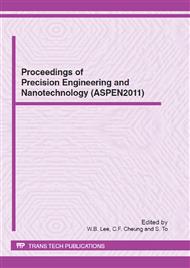p.96
p.102
p.108
p.113
p.119
p.125
p.130
p.136
p.142
Smoothing Mechanism of Reaction Sintered SiC in Plasma Assisted Polishing Using Ceria Abrasive
Abstract:
For the finishing of some difficult-to-machine materials, a novel polishing technique named plasma assisted polishing (PAP) was proposed. Ceria abrasive polishing with different electric power plasma irradiation was conducted on RS-SiC surface. Low RF power plasma (8 W) was used, many protrusions were generated which made the surface roughnesses bad (60.93 nm p-v, 5.51 nm rms). In contrast, the height and amount of protrusions decreased when RF power was increased to 12 W, which made the surface roughness better (31.83 nm p-v, 2.63 nm rms). Also, scratches completely disappeared after PAP. To explain the above results, the relationship of oxidation rate by plasma irradiation and material removal rate by abrasive polishing was taken into consideration. The different compositions in RS-SiC have different oxidation rates and levels of hardness. When the oxidation rate is higher than material removal rate, the heterogeneous polishing of RS-SiC is turned to homogeneous polishing of SiO2, and then a flat surface with an oxide layer can be obtained. To prove the above assumption, we firstly oxidized the surface with plasma irradiation for 1 h, and then PAP with a much lower load was conducted on the oxidized surface for 0.5 h. A scratch-free surface with 12.61 nm p-v and 1.45 nm rms was obtained which coincides with the mechanism we propose.
Info:
Periodical:
Pages:
119-124
Citation:
Online since:
June 2012
Authors:
Price:
Сopyright:
© 2012 Trans Tech Publications Ltd. All Rights Reserved
Share:
Citation:


